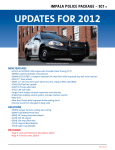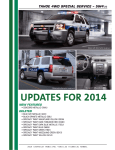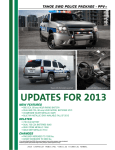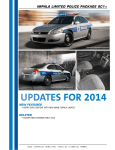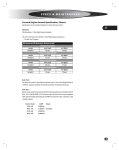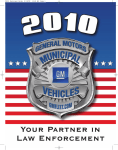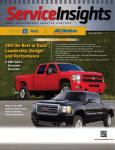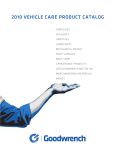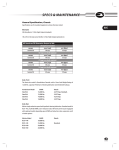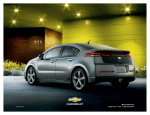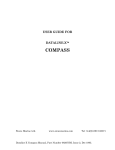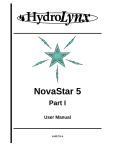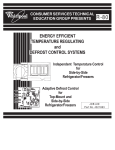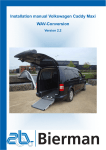Download uPdatES for 2014
Transcript
SUBURBAN COMMERCIAL FLEET 1FL | 1 Updates for 2014 New Features • Concord Metallic Deleted • • • • • • • • • • Blue Ray Metallic (GXH) Black Granit Metallic (58U) Specialty Paint Wheatland Yellow (253A) Specialty Paint Dark Toreador Red (334D) Specialty Paint Dark Blue Metallic (722J) Specialty Paint Blue (5665) Specialty Paint Green (7941) Specialty Paint Woodland Green (9015) Specialty Paint Yellow (9414) No 3/4 ton models for 2014 model year 2014 Chevrolet Municipal Vehicles Technical Manual 2 | SUBURBAN COMMERCIAL FLEET 1FL NOTE: This vehicle is NOT designed nor intended for use IN HIGH SPEED EMERGENCY VEHICLE OPERATIONS Model availability Cc10906 Ck10906 Rear-wheel drive 1/2 ton 4-wheel drive 1/2 ton Standard equipment summary Warranty 3 years / 36,000 miles bumper-to-bumper (whichever comes first, see dealer for details) 5 years / 100,000 miles limited powertrain (whichever comes first, see dealer for details) Interior features Air conditioning Tri-zone manual climate control with individual climate settings for driver and right-front passenger; includes auxiliary rear air conditioning and heat Assist handles Front passenger and second row outboard; front passenger assist handle is deleted when passenger side spotlamp is ordered Console, overhead Mini with map lamps Cruise control Electronic with set and resume speed Dome LampsInterior dome lamp, driver and passenger side door switch with delayed entry feature, cargo lamps, remote keyless entry activated illuminated entry and map lamps in front and second seat position Floor covering Black rubberized-vinyl (not available with b39 cargo mat) Glass Deep tinted (all windows except light-tinted glass on windshield, driver and front passenger side glass) Mirror Inside rearview auto-dimming OnStar Delete option available Power outlets 12-volt, two located on instrument panel and one in rear cargo area Radioam/fm stereo with mp3 compatible cd player, seek-and-scan, digital clock, auto-tone control, Radio Data System (rds), six speakers, speed-compensated volume and theftlock Restraint system Safety belts, driver and front passenger with pretensioners, dual stage driver and passenger frontal air bags1, passenger sensing system and frontal air bag1 ON/OFF indicator, rollover sensor, dual head curtain air bags1 for first and second row outboard occupants and front seat back mounted thorax-pelvic air bags1; includes 3rd row outboard seating position when 3 passenger third row 50/50 split-bench option AS3 is ordered Seat, frontSplit-bench 40/20/40 with custom cloth 3-passenger, includes 6-way power driver seat adjuster with manual lumber control, driver and passenger manual reclining, outboard head restraints, center fold-down covered storage in armrest, center lower seat cushion storage and rear storage pockets Seat, rearCustom cloth 60/40 split folding bench with center armrest Seat, third row 50/50 split-bench 3-passenger with premium cloth, safety belts, removable seat Speedometer/cluster 120 mph analog speedometer, trip odometer, fuel level, volt meter, engine temperature oil pressure and tachometer Steering column/wheel Tilt-wheel, adjustable, with brake/transmission interlock Theft deterrent Vehicle theft PASS-Key® III+, content theft deterrent is disabled (to enable content theft deterrent option ua6 must be ordered) Visors Padded with cloth trim, extends on rod; driver and front passenger illuminated vanity mirrors Warning toneS Headlamp on, key-in-ignition, driver and right-front passenger safety belt unfasten and turn signal on Window operation Power with driver express-down and lockout features 1. H ead curtain side air bags are designed to help reduce the risk of head and neck injuries to front and rear seat occupants on the near side of certain side-impact collisions. Always use safety belts and the correct child restraints for your child’s age and size, even in vehicles equipped with air bags. Children are safer when properly secured in a rear seat. See your vehicle Owner’s Manual and child safety seat instructions for more information. 2014 Chevrolet Municipal Vehicles Technical Manual SUBURBAN COMMERCIAL FLEET 1FL | 3 Exterior features Assist steps Black, mounted between front and rear wheels Defogger Electric, rear window Door handles Black Door locksPower programmable with lockout protection, door lock cylinder no longer available on passenger front door and rear liftgate Fascia, front Color – keyed (Black when special paint is ordered) Fascia, rear Color – keyed (Black when special paint is ordered) Headlamps Dual halogen composite with automatic exterior lamp control and flash-to-pass feature Keyless entryIncludes two transmitters Keys Single two-sided, random code, for ignition and drivers door only Luggage rack Roof mounted Black side rails (center rails and luggage rack delete are available) Mirrors Outside heated power-adjustable, manual-folding, Black Rear liftgate Liftgate/liftglass, with rear window washer and wiper (power liftgate not available) Recovery hooks Two front, Black (Chrome only available on LTZ) Windshield wipers Intermittent wet-arm with flat blade and pulse washers Chassis features Alternator160-amp Battery 660 CCA, maintenance-free, rundown protection and retained accessory power Brakes4-wheel antilock, 4-wheel disc, vac power Engine See engine, transmission and axle chart on page 4 Frame Modular with hydro formed frame rails Fuel tank CAPACITY 31 gallon (117.3 liters) Oil coolersAuxiliary transmission oil cooler, heavy-duty air-to-oil (requires 3.42 axle ratio on 1/2 ton models) Stabilitrak Vehicle stability control system with proactive roll avoidance Steering Power, rack and pinion Suspension, front Coil-over-shock with stabilizer bar Suspension, rear Multi-link with coil springs Tires See tire and wheel chart on page 5 Tire pressure monitor CHECK TIRE PRESSURE will show on Driver Information Center (no sensor in spare tire) tire, Spare See tire chart on page 5 tire, Spare carrier Lockable outside, winch-type mounted under frame at rear Trailering equipmentHeavy-duty includes trailering hitch platform, 7-wire harness with independent fused trailering circuits mated to a 7-way sealed connector and vr4 2-inch trailering receiver. Electronic trailer sway control and hill start assist Transfer caseActive single-speed, electronic autotrac with rotary controls, does not include Neutral (N). Cannot be dinghy towed, requires GU4 3.08 rear axle. Not available on 2WD models Transmission 6-speed automatic, see engine, transmission and axle chart on page 4 Wheels See wheel and tire chart on page 5 2014 Chevrolet Municipal Vehicles Technical Manual 4| SUBURBAN COMMERCIAL FLEET 1FL C ommercial fleet package option 1 FL ENGINE/AXLE S = Standard Equipment A = Available – (dashes) = Not Available TRANSMISSIONAXLEGVWR lbs. (kg) MODEL ENGINE MYC 6-SPEED MYD 6-SPEED GU4 GU6 GT4 AUTOMATIC AUTOMATIC HD 3.08 3.42 3.73 CC10906 CK10906 C5Z 7200 (3266) C6C C6P 7400 8600 (3357) (3901) LMG Vortec 5.3L V8 SFI FlexFuel2 S — S A — S — — LC9 Vortec 5.3L V8 SFI FlexFuel2 S — S A — — S — NOTE: E mission type must be ordered FE9 - Federal YF5 - California NG1 - Northeast States TRAILERING SPECIFICATIONS Automatic Transmission Ratings with Ball Hitch (LMG) Vortec (LC9) Vortec 5.3L 5.3L V8 SFI FlexFuel2V8 SFI FlexFuel2 MODEL Axle Ratio CC10906 CC10906* CK10906 CK10906* Maximum TrailerAxle Ratio Weight lbs.7 (kg) 3.08 3.42 3.42 — — 5100 (2313) 5600 (2540) 8100 (3674) — — Maximum Trailer Weight lbs.7 (kg) — — — — — — 3.42 3.42 5500 (2495) 8000 (3629) *with (K5L) heavy-duty Trailering Package GCWR - ENGINE/REAR RATIO COMBINATION WITH AUTO TRANS ENGINE (LMG) Vortec 5.3L V8 SFI FlexFuel2 (LC9) Vortec 5.3L V8 SFI FlexFuel2 (L96) Vortec 6.0L Variable Valve Timing V8 SFI FlexFuel2 (GCWR) Gross Combination Weight Ratings lbs. (kg) 11000 14000* (4989) (6350) 3.08 3.42 — 3.42 — — *with (K5L) heavy-duty Trailering Package 2. E85 is 85% ethanol and 15% gasoline. To see if there is an E85 station near you, go to www.gmaltfuel.com/e85-station-locator. 7. M aximum trailer weight ratings are calculated assuming a base vehicle, except for any option(s) necessary to achieve the rating, plus driver. The weight of other optional equipment, passengers and cargo will reduce the maximum trailer weight your vehicle can tow. 2014 Chevrolet Municipal Vehicles Technical Manual SUBURBAN COMMERCIAL FLEET 1FL | 5 Tires and wheels CODE QAN QJP SIZE P265/70R17 P265/70R17 Spare Tires CODE ZRS 4JP SIZE P265/70R17 P265/70R17 DESCRIPTION All-season On/off-road CODE NX7 P46 SIZE 17" x 7" 17" x 7.5" DESCRIPTION 4 – steel 4 – 5 spoke Spare Wheels CODE NZ4 SIZE 17" Road Tires DESCRIPTION All-season On/off-road SIDE WALLUSAGE Blackwall Standard Blackwall Optional MODELS 1/2 ton 2 or 4WD 1/2 ton 4WD SIDE WALLUSAGE Blackwall Standard Blackwall Optional MODELS 1/2 ton 1/2 ton (requires QJP tires) Road Wheels DESCRIPTION One – steel SIDE WALLUSAGE Steel Standard Aluminum Optional MODELS 1/2 ton 1/2 ton SIDE WALLUSAGE MODELS Steel Standard1/2 ton NOTE: Polished forged aluminum, includes chrome center caps and steel spare Seats and interior trim S = Standard Equipment A = Available -- (dashes) = Not Available Interior Decor Level Seat Seat Seat TrimEbonyLight Light TypeCodeCashmere/Titanium/ Dark Dark Cashmere 1 Titanium1 Standard Front: 40/20/40 AZ3 Premium cloth 19C 33C — Commercial (1FL) reclining split-bench Available Front: 40/20/40 AZ3 Vinyl 19V — — Commercial (1FL) reclining split-bench Optional Front: high-back A95 Premium cloth 19C 33C — Commercial (1FL) reclining bucket Interior Exterior Color Touch Up EbonyLight Titanium/ Dark Cashmere/ Solid PaintCodePaint NumberDark Titanium4Light Cashmere4 Black 41U WA-8555 A A A Mocha Steel Metallic GHA WA-7065 A A A Summit White 50U WA-8624 A A A Silver Ice Metallic1 GAN WA-636R A A A Crystal Red Tintcoat1 89U WA-505Q A A A Concord Metallic1 GWU WA-103V A A A Champagne Silver Metallic GWT WA-102V A A A 1 - Extra Cost 2014 Chevrolet Municipal Vehicles Technical Manual 6 | SUBURBAN COMMERCIAL FLEET 1FL AVAILABLE EXTERIOR COLORS GAN 41U GHA 50U 89U GWU GWT Silver Ice Metallic Black Mocha Steel Metallic Summit White *Crystal Red Tintcoat *Concord Metallic (New) Champagne Silver Metallic NOTE: * Additional Charge Actual colors may vary SEO Paint Available WA# COLOR DESCRIPTION 9260Victory Red CODE Requires SEO 5T4 Actual Color May VAry NOTE: • All normally body-colored, non-sheet metal parts, will be Flat Black (except Victory Red non-sheet metal parts will match) • SEO paint orders that contain less than five vehicles will be delayed until five unit minimum is received for batch production 2014 Chevrolet Municipal Vehicles Technical Manual SUBURBAN COMMERCIAL FLEET 1FL | 7 Available options W2D Accessory - Cargo net K47 air cleaner - High capacity Jl1 brake controller - Integrated trailer D07 console - Floor storage area and cup holders (included and only available with a95 front custom cloth bucket seats) Utq content theft alarm disable - Flashing lamps and horn warning Knp cooling - Auxiliary transmission oil cooler. (Included and only available with k5l Hd Trailerling Package7 on 1/2 ton) Kc4 cooling - External engine oil cooler (Included and only available with k5l Hd Trailerling Package7 on 1/2 ton) G80 differential - Heavy-duty locking rear K05 engine blOck heater B30 floor covering - Color-keyed carpeting (includes b58 color keyed floor mats) VAVfloor mats, all weather - First and second row, requires B30 color-keyed carpeting. Not available with AZE front 40/20/40 split-bench on 2WD models. (LPO, dealer installed) VKNfloor mats, all weather - Third row, requires B30 color-keyed carpeting and AS3 third row 50/50 split-bench seats. Not available with AZE front 40/20/40 split-bench on 2WD models. (LPO, dealer installed) T96 fog lamps - Front, halogen Anj glass - Non-deep tinted K5l heavy-duty trailering package7 - Includes auxiliary transmission oil cooler and external engine oil cooler, (Includes 3.42 ratio rear axle) V1k luggage rack center rails - Roof mounted, Black G63 luggage rack - Delete VLI Mat, rear cargo - Requires B30 color-keyed carpeting. Not available with ATD third row seat delete. (LPO, dealer installed) B58 mats - Color-keyed carpeted first and second row, removable (included and only available with b30 floor covering) Dpnmirrors - Outside heated power-adjustable vertical camper; manual-folding, extension and integrated turn signal indicators Ueo OnStar - Delete VBS remote, 2-way advanced - (LPO, dealer installed) Ap3 remote vehicle starter system - Includes remote keyless entry Ud7 rear parking assist - Ultrasonic with led display and audible warning (requires jf4 power-adjustable pedals) V76 recovery hooks - Front, frame mounted, Black (Chrome only available on LTZ) Trw roof mounted lamp - Provisions (included with vyu Snow Plow Prep Package ) Nzzskid plate package - Requires 4-wheel drive model, includes aluminum front underbody shield starting behind front bumper and running to first cross-member, protecting front underbody, oil pan, differential case and transfer case, frame-mounted shield, requires 4-wheel drive model UVD Steering wheel - Heated (standard on LTZ trim) NQH Transfer case - Active 2-speed electronic autotrac with rotary controls includes neutral position for dinghy towing, requires 4WD models Special Equipment Options available 5t4exterior body-colored parts - Victory Red with special paint wa9260; Victory Red painted front and rear fascias, rear liftgate handle and rear license plate applique, body side moldings and door handles. Required with Victory Red special paint WA9260 9n5floor console delete - Deletes floor console and associated audio equipment that is included with premium cloth high-back buckets seats; requires: peg 1fl and RPO a95 bucket seats 8X1 Label, Fasten Safety Belts - On Left hand and right hand front door window glass 9g3off-road suspension - Off-road suspension 4x4 commercial or low uplevel décor; includes z71, off-road suspension components, skid plate and high capacity air cleaner; does not include body side “z71” decals; requires: model k10906 option qjp p265/75r17 on-off road tires peg 1fl Suburban 1ls or 1lt Uplevel Package and a fleet or government type order 5t5seats, cloth front vinyl rear - Vinyl 2nd row rear seats and cloth front seats; if as3 third row seat is ordered, it will be vinyl. Requires: az3 front custom cloth 40/20/40 bench seat or a95 front custom cloth high-back bucket seat, trim code 19d Ebony and peg 1fl 9s1seats, driver and passenger front individual seats in vinyl trim - Derived from RPO ae7 40/20/40 split-bench with center 20% section removed; seats are manual, not power; does not include floor console; exposed floor areas will remain untrimmed; rear seats will also be vinyl trimmed; requires trim code 19v Ebony and peg 1fl 7. M aximum trailer weight ratings are calculated assuming a base vehicle, except for any option(s) necessary to achieve the rating, plus driver. The weight of other optional equipment, passengers and cargo will reduce the maximum trailer weight your vehicle can tow. 2014 Chevrolet Municipal Vehicles Technical Manual 8 | SUBURBAN COMMERCIAL FLEET 1FL EMISSIONS - MUST BE SPECIFIED FE9 F ederal emissions. Use for ordering vehicles that will be registered in all states except California, Connecticut, Maine, Maryland, Massachusetts, New Jersey, New Mexico, New York, Oregon, Pennsylvania, Rhode Island, Vermont and Washington State YF5 California emissions. Use for ordering vehicles that will be registered in California. NE1CT/ME/MD/MA/NJ/NM/NY/OR/PA/RI/VT/WA emissions. Use for ordering vehicles that will be registered in Connecticut, Maine, Maryland, Massachusetts, New Jersey, New Mexico, New York, Oregon, Pennsylvania, Rhode Island, Vermont or Washington State NB8 Required when option code FE9 “Federal emissions” is ordered for delivery to a dealer located in California, Connecticut, Massachusetts, Maryland, New Jersey, New Mexico, New York, Oregon, Pennsylvania, Rhode Island and Washington State for a purchaser who will be registering the vehicle outside California, Connecticut, Maine, Maryland, Massachusetts, New Jersey, New Mexico, New York, Oregon, Pennsylvania, Rhode Island, Vermont and Washington State. NC7 Required when option code YF5 “CALIFORNIA EMISSIONS” or option code NE1 "CT/ME/MD/MA/NJ/NM/NY/OR/PA/RI/VT/WA EMISSIONS" is ordered for delivery to a dealer located in any state except California, Connecticut, Maine, Maryland, Massachusetts, New Jersey, New Mexico, New York, Oregon, Pennsylvania, Rhode Island, Vermont and Washington for a purchaser who will be registering the vehicle in one of these states or sold as permitted below under “EPA Policy on the Sale of California Emission Vehicles” NB9 Required when option code YF5 is ordered for delivery to a dealer located in Connecticut, Maine, Maryland, Massachusetts, New Jersey, New Mexico, New York, Oregon, Pennsylvania, Rhode Island, Vermont and Washington. Required when option code NE1 is ordered for delivery to a dealer located in California. 2014 Chevrolet Municipal Vehicles Technical Manual SUBURBAN COMMERCIAL FLEET 1FL | 9 Interior Specifications (in./mm) Wheelbase Overall length Body width Overall height Head room, front Head room, center Head room, rear Shoulder room, front Shoulder room, center Shoulder room, rear Hip room, front Hip room, center Hip room, rear Leg room, front Leg room, center Leg room, rear Ground to top of rear load floor Load floor length, to front seat, at floor Load floor length, to center seat, at floor Load floor length, to rear seat, at floor Inside width, between wheelhousing Cargo area height Ground clearance, front Ground clearance, rear Front shock absorber diameter Front stabilizer bar diameter Rear shock absorber diameter Rear stabilizer bar diameter Turning diameter, curb-to-curb, ft. (m) Capacities lbs. (kg) Front axle Rear axle Curb weight Cargo volume3, cu. ft. (liters) Payload6 Gross Vehicle Weight Rating5 (GVWR) Front Gross Axle Weight Rating (FGAWR) Rear Gross Axle Weight Rating (RGAWR) Fuel capacity, approximate, gallon (liters) Seating capacity (front/center/rear) CC10906 2WD 1/2 Ton CK10906 4x4 1/2 Ton 130.0/3302 222.4/5649 79.1/2009 76.8/1951 41.1/1044 38.5/978 38.1/968 65.2/1656 65.2/1656 64.7/1643 60.3/1532 61.8/1570 49.4/1255 41.3/1049 39.5/1003 34.9/886 31.8/808 101.8/2586 69.6/1768 35.6/904 49.1/1247 41.4/1052 10.5/267 9.1/231 1.81/46 1.41/36 1.81/46 1.10/28 43.0/13.1 130.0/3302 222.4/5649 79.1/2009 76.8/1951 41.1/1044 38.5/978 38.1/968 65.2/1656 65.2/1656 64.7/1643 60.3/1532 61.8/1570 49.4/1255 41.3/1049 39.5/1003 34.9/886 32.6/828 101.8/2586 69.6/1768 35.6/904 49.1/1247 41.4/1052 10.5/267 9.1/231 1.81/46 1.41/36 1.81/46 1.10/28 43.0/13.1 3500/1588 4200/1905 5672/2573 137.4/3891.2 1528/693 7200/3266 3500/1588 4200/1905 31/117 3/3/03 3600/1633 4200/1905 5824/2642 137.4/3891.2 1576/715 7400/3357 3600/1633 4200/1905 31/117 3/3/03 NOTE: P ublished dimensions indicated are without optional equipment or accessories. Additional accessories or equipment ordered at the customer's request can result in a minor change in these dimensions. 3. Cargo and load capacity limited by weight and distribution. 5. Gross Vehicle Weight Rating (GVWR). When properly equipped, includes vehicle, passengers, cargo and equipment. 6. Maximum payload capacity includes weight of driver, passengers, optional equipment and cargo. 2014 Chevrolet Municipal Vehicles Technical Manual 10 | AIR BAGS FAQ Can specialty vehicle equipment (e.g. radar devices, video cameras, computers, meters, radio trees, shotguns, etc.) still be mounted in cars with passenger side air bags? Yes, but care must be taken to mount the equipment outside of the deployment zone. Air bags inflate with great force and will interact with any object in the deployment zone. Therefore, to reduce the risk of injury to vehicle occupants, GM recommends that the air deployment zone be kept free of any equipment. If a piece of equipment were to become dislodged it could strike an occupant in the vehicle and result in injury. The likelihood of an object becoming dislodged is influenced by many factors, including the proximity of the object to the inflatable restraint, the size and shape of the object, and the means by which the object is secured to the vehicle. In addition to these factors, the trajectory and velocity of a dislodged object can be influenced by the type and severity of vehicle crash. Objects that are in the deployment zone, but do not become dislodged by an inflating air bag can still affect the performance of the air bag. For example, such objects could tear the fabric or affect the shape of the air bag, thus reducing the ability of the bag to provide restraint. Is it possible to shield equipment that is installed in the passenger side frontal air bag deployment zone in a manner that will allow full and safe air bag deployment? Due to the complexity of influencing variables, GM is unable to evaluate the potential for shielding expected equipment configurations in all accident scenarios in order to assure that the air bag performance would be unaffected. While shielding may protect certain equipment from being damaged or dislodged, it may also negatively affect the inflation characteristics of the air bag. The air bag’s shape, inflation angle, fold pattern, and inflation rate and pressure are developed to maximize the protection capability of the inflatable restraint system. Therefore, GM cannot recommend the placement of any equipment in the deployment zone, even if it is shielded to protect it from damage. Front air bag systems and instrument panel mounted equipment. Passenger air bags in GM vehicles deploy in different ways depending upon the type of vehicle and the particular instrument panel design. In some vehicles, the passenger air bag deploys through a discrete door located on the top surface of the instrument panel (top-mount air bag systems). In other vehicles, such as the Chevrolet Tahoe, the passenger air bag deploys through a discrete door mounted on the vertical rearward surface of the instrument panel, above the glove box door (mid-mount air bag system). With these types of topmount and mid-mount passenger air bag systems, the top pad of the instrument panel remains in place during deployment. Some GM passenger air bag systems, like the system in the Chevrolet Impala, deploy from beneath the instrument panel top pad. These are considered 3/4-mount air bag systems with a “deployable top pad.” The entire instrument panel top pad is the “deployment door” from under which the inflating air bag emerges. When an air bag deployment is commanded, the forces from the inflating passenger air bag push up on the instrument panel top pad, releasing special fasteners across the rearward edge of the top pad. This allows the top pad to rotate upward so that the passenger air bag may emerge. The top pad rotates upward to open widest at the right hand side, and is usually forced upward into contact with the windshield on the right hand side of the vehicle during a deployment. Instrument panel top mounted special equipment, such as a radar antenna and control unit or video camera must be positioned to the left of the vehicle center line. This equipment must be mounted as low as possible and securely fastened to the top pad to avoid being dislodged in the event of a crash and possible air bag deployment. In the process of securely fastening special equipment to the top, DO NOT fasten down the top pad itself to any other vehicle component such as the cluster trim plate. As described above, the top pad rotates upward during a deployment. In order to enable the proper deployment of the passenger air bag, specialty equipment installation MUST NOT PREVENT the top pad from rotating upward during deployment. Location and attachment of special equipment should minimize added resistance or interference to upward rotation of the top pad during deployment. Side-Impact Air Bags for crashes to the vehicle sides. The air bag system in your police vehicle includes includes roof rail mounted Head Curtain side air bags.. The vehicle is also equipped with seat back mounted upper body air bags located on the outboard side of the driver and front passenger seat backs. Together the Head Curtain and seat-mounted side air bags are intended to protect the head and upper body in the event of a side crash. Some vehicles may also be equipped with an optional air bag, mounted on the inboard side of the driver seat back. Can Specialty Vehicle Security Barriers be mounted within the side air bag deployment zones? No. The side air bags inflate extremely fast because of the nature of side crashes to the vehicle. Mounting a security barrier behind the front seats with the ends placed within the side air bag deployment zones will result in unintended interaction between the barrier and the inflating side air bags. To reduce the risk of injury to the vehicle occupants, GM recommends that the side air bag zones be kept free of any customer installed equipment. Customer furnished equipment installed to the vehicle roof. Your police vehicle is designed with an interior roof cover system which includes internal components for the interior lamps and wiring. The roof system may also include side air bag components. Inflation devices may be mounted on the vehicle roof side behind the rear doors as well as air bag tethers retained to the windshield pillars. Care must be taken to avoid damage to these components or interference with their operation when installing roof mounted equipment such as emergency lamps and communication antennas. Recommended GM service procedures must be followed to remove and re-install the instrument panel top pad to ensure that the top pad will release properly in the event of a passenger air bag deployment. On the right half of the top pad closest to the passenger air bag module, GM recommends that no equipment be mounted. When mounting equipment on the driver side of the top pad, GM recommends that the total mass of the top pad mounted special equipment not exceed 8 pounds (3.6 kilograms), since some top pads tend to rotate about the left end. Fasteners used to secure special equipment to the instrument panel top pad, the windshield glass, or to the windshield upper frame (header), should be selected to ensure that these devices will remain attached during a vehicle crash and possible air bag deployment. ead curtain side air bags are designed to help reduce the risk of head and neck injuries to front and rear seat occupants on the near side of certain side-impact collisions. Always H use safety belts and the correct child restraints for your child’s age and size, even in vehicles equipped with air bags. Children are safer when properly secured in a rear seat. See your vehicle Owner’s Manual and child safety seat instructions for more information. 2014 Chevrolet Municipal Vehicles Technical Manual AIR BAGS FAQ | 11 Can the installation of push bumpers on the front end of the vehicle affect the deployment of the air bag? I've heard that a deployed air bag produces whet appears to be smoke, is the air bag hot? General Motors is not aware of adverse effects during crash events from the many push bumpers thai have been installed on GM police vehicles. Because there are many styles of push bumpers available with varying crash characteristics, installation of push bumpers may or may not affect deployment timing of the air bags. Push bumpers should be mounted to avoid modifying the vehicle structure and interfering with the front air bag sensors mounted on the upper radiator support cross member After the bag has deployed in a crash, the air bag itself will not be hot to touch. Some components within the air bag module will be hot for a short time. A small amount of smoke coming from a deployed air bag module is normal and should not be cause for concern. Two front impact sensors are installed in General Motors vehicles. Do not relocate or disconnect the front sensors. The location and orientation of the front sensors are critical for correct operation of the air bag system. Avoid mounting components on or near the sensors. Push bumper styles with vertical pushing members that are in foreaft alignment with the front air bag sensors are not recommended. When should an air bag inflate? The driver's and right-front passenger's frontal air bags are designed to inflate in moderate to severe frontal or near-frontal crashes. But they are designed to inflate only if the impact speed is above the system's designed "threshold level." In addition, your vehicle has “dual stage” frontal air bags which tailor the the amount of restraint according to crash severity. For moderate frontal impacts, the air bags inflate at a level less than full deployment. For more severe frontal impacts, "dual stage" frontal air bags deploy at full levels. If the front of your vehicle goes straight into a wall that doesn't move or deform, the threshold level of the reduced deployment is about 12 to 16mph (19 to 15 km/h), and the threshold level for a full deployment is about 18 to 24 mph (29 to 28.5 km/h). The threshold level can vary, however, with specific vehicle design, so that it can be somewhat above or below this range. If your vehicle strikes something that will move or deform such as a parked car, the threshold level will be higher. The driver's and right-front passenger's frontal air bags are not designed to inflate in rollover, side impacts, or rear impacts, because inflation would not help the occupant. Seat mounted side impact air bags are designed to inflate in moderate to severe side crashes. The side impact air bags will inflate if the crash severity is above the designed "threshold level." The threshold level can vary with specific vehicles design. The side impact air bags are not designed to inflate on frontal or near-frontal impacts or rear impacts, because inflation would not help the occupant. Also, when the nitrogen gas is vented out of the air bag, small particles from inside the bag are also vented into passenger compartment. These airborne particles look like smoke and some particles are deposited as residue on and around the air bag. I've heard that the dusts that are released into the passenger compartment from the air bag are harmful, is this true? For most people, the only effect the dusts will produce is some irritation of the throat and eyes, and that is only if the occupant remains in the vehicle for many minutes after the air bag deployment with no ventilation and windows closed. However, some people with asthma may develop an asthmatic attack from inhaling the dusts. If this happens, they should first treat themselves the same way their doctor has advised them to treat any other asthma attack, and then immediately seek medical treatment. Can the air bag system be re-used? No, The air bags are designed to inflate only once. After inflation some new parts will be required. These will include the air bag module and possibly other parts. (A competent service technician with access to the vehicle's service manual and the required tools should replace the required components after a deployment crash.) If my vehicle has air bags, why should I have to wear my safety belt? Air bags are in many vehicles today and will be in most of them in the future. But they are supplemental systems only; so they work with safety belts not instead of them. Every air bag system ever offered for sale has required the use of safety belts. Even if you're in a vehicle that has air bags, you still have to buckle up to get the most protection. That's true not only in frontal collisions but especially in side and other collisions. Roof rail mounted head-curtain air bags are designed to inflate in moderate to severe side crashes. In addition, certain vehicles have head-curtain air bags which are also designed to inflate in situations where an impending rollover condition is identified by the vehicle's rollover sensing system and/or frontal or near-frontal impacts if the crash severity is above the designed "threshold level". Safety belt pretensioners at the driver and front passenger seat positions are designed to deploy in frontal, near-frontal, side, and rear crashes that exceed the "threshold level" of crash severity to help reduce slack in the safety belt Safety belt pretensioners will also deploy in impending rollover situations. How long will the air bag remain inflated? It takes approximately 1/20th of a second to fully inflate the frontal air bags. This is faster than the blink of an eye. The air bags begin to deflate immediately, helping to stop the occupants more gradually. ead curtain side air bags are designed to help reduce the risk of head and neck injuries to front and rear seat occupants on the near side of certain side-impact collisions. Always H use safety belts and the correct child restraints for your child’s age and size, even in vehicles equipped with air bags. Children are safer when properly secured in a rear seat. See your vehicle Owner’s Manual and child safety seat instructions for more information. 2014 Chevrolet Municipal Vehicles Technical Manual 12 | AIR BAGS Top View of Instrument Panel and APproximate Deployment Area of the Air bag Zone A. B. C. D. E. F. G. H. I. J. K. L. M. Passenger side instrument panel top surface zone Passenger side air bag module trim panel – rear edge Passenger side door Approximate dimensions of inflated air bag Passenger side air bag deployment zone Passenger centerline Inside rearview mirror Vehicle centerline Driver centerline Driver side air bag deployment zone Front of steering wheel Driver side door Shift selector arc ead curtain side air bags are designed to help reduce the risk of head and neck injuries to front and rear seat occupants on the near side of certain side-impact collisions. Always H use safety belts and the correct child restraints for your child’s age and size, even in vehicles equipped with air bags. Children are safer when properly secured in a rear seat. See your vehicle Owner’s Manual and child safety seat instructions for more information. NOTE: All dimensions are approximate and subject to change. 2014 Chevrolet Municipal Vehicles Technical Manual AIR BAGS | 13 Side View of Driver Side Air bag Deployment Zone A. Top edge of windshield B. Top of instrument panel C. Inflated air bag – steering wheel D. Centerline of steering column at mid-tilt E. Driver air bag deployment zone F. Front of steering wheel Side View of Passenger Side Air bag Deployment Zone A. Top edge of windshield B. Inside rearview mirror C. Instrument panel top surface zone D. Passenger side air bag module trim panel – rear edge E. Inflated air bag – horizontal dimension approximate 15.4 in (390 mm) F. Inflated air bag – vertical dimension approximate 9.3 in (490 mm) G. Inflated air bag – instrument panel H. Passenger air bag deployment zone ead curtain side air bags are designed to help reduce the risk of head and neck injuries to front and rear seat occupants on the near side of certain side-impact collisions. Always H use safety belts and the correct child restraints for your child’s age and size, even in vehicles equipped with air bags. Children are safer when properly secured in a rear seat. See your vehicle Owner’s Manual and child safety seat instructions for more information. NOTE: All dimensions are approximate and subject to change. 2014 Chevrolet Municipal Vehicles Technical Manual 14 | AIR BAGS Head Curtain and front Seat-Mounted Side IMpact Air bag Deployment Zones Passenger Side Shown, Driver Side Similar Tahoe/Suburban/Silverado Crew Cab Seat Rows 1 and 2 A. Top of deployment zone – along head curtain at edge of headliner B. Back of deployment zone – at rear top corner of rear door pad C. Rear quarter window D. Bottom outside edge of rear quarter window E. Bottom of air bag deployment zone – parallel to outside bottom edge of rear quarter glass F. Top edge of rear door pad G. Top edge of front door pad H. Dimension at mirror patch from top edge of front door pad I. Front of deployment zone at front upper corner of front door pad J. Windshield pillar trim with grab handle K. Visor L. Deployment zone - Tahoe seat rows 1 and 2 Tahoe/Suburban 3rd Row Seats M. Deployment zone - Tahoe 3rd seat N. Deployment zone - Suburban 3rd seat O. Rear zones at back corner of headliner: 1 Tahoe, 2 Suburban P. Bottom of 3rd seat zone at rear side trim cup holders Q. Top edge of rear quarter trim at window R. Rear of Tahoe S. Rear of Suburban Tahoe/Suburban/Silverado Crew Cab Seat Air bag T. Center of door trim pull handle U. Top of surface of outboard front seat cushion V. Back edge of center pillar trim NOTE: The head curtain air bag inflators are mounted in a different orientation on the Silverado Crew Cab pickup truck roof structure from those in the Tahoe/Suburban. Head curtain and front Seat-Mounted Side IMpact Air bag Deployment Zones View from Rear Cargo Area A. Head curtain air bag deployment zone B. Underside of headliner C. Edge of headliner D. Inner center pillar trim E. Inner door pad F. Seat centerline G. Bottom of door windows H. Front seat headrests I. Seat-mounted side impact air bags deployment zone front seat J. Top surface of outboard front seat cushion ead curtain side air bags are designed to help reduce the risk of head and neck injuries to front and rear seat occupants on the near side of certain side-impact collisions. Always H use safety belts and the correct child restraints for your child’s age and size, even in vehicles equipped with air bags. Children are safer when properly secured in a rear seat. See your vehicle Owner’s Manual and child safety seat instructions for more information. NOTE: All dimensions are approximate and subject to change. 2014 Chevrolet Municipal Vehicles Technical Manual Anti-lock braking system FAQ | 15 GM offers Anti-Lock Brake Systems as standard or optional on all North American passenger vehicles and light truck lines. The computerized Anti-Lock Braking System (ABS) is designed to keep the vehicle’s wheels rotating as the brakes are applied to assist the driver in achieving a controlled stop. Sensors monitor how fast the wheels rotate and feed the data continuously to the ABS computer. The vehicle’s brakes slow each wheel as the brake pedal is applied. However, when ABS is activated due to road conditions, the system repeatedly releases and applies pressure to the brakes. The wheels can keep rolling, thus retaining steering ability and enhanced stability while providing a higher braking force on most surfaces than a locked wheel provides. How exactly does ABS work? In cars without ABS, hitting the brakes can cause the wheels to lock, leaving you unable to steer the vehicle until you decrease the pressure so the wheels can roll again. With an ABS, as you apply the brakes, the ABS computer monitors the wheel speed sensor information. If the computer senses that a wheel is approaching lock up, it sends a signal to the hydraulic modulator to reduce, then to reapply, brake pressure several times a second for as long as you maintain firm pressure on the brake pedal. The process is much like the threshold braking technique used with conventional brakes. However, ABS does it much faster and more accurately than any driver can, leaving you free to focus on steering away from obstacles. Does ABS reduce stopping distances? Should I drive an ABS equipped vehicle differently than I would drive a vehicle with conventional brakes? Most of the time, under normal driving circumstances, there is no difference, and you should always drive with the same caution and care. It is important to realize that ABS only makes a difference when it is activated—when you have to brake hard—and that would only be when the computer senses that a wheel is approaching lockup. When ABS activates, keep steady pressure on the brake pedal and then let the ABS work for you. Don’t pump the brakes or try to find the threshold. Simply hold the brake pedal down and steer if necessary to avoid an obstacle. Is ABS always active? ABS is always available, but not always activated. ABS is activated only when the brake pedal is applied and the computer detects an impending wheel lock condition. Can older cars be retrofitted with ABS? No! The brake system is one of the most important features on any passenger vehicle. Several products, which tap into the master cylinder and/or brake system performance, are being sold in the aftermarket. Some of these products imply performance similar to new vehicle anti-lock brake systems. However, contrary to their claims, add-on systems, which deplete fluid from the master cylinder on brake apply may actually increase a vehicle’s stopping distance. This may cause the vehicle to fail to comply with Federal brake standards. Does ABS always activate at the same speed? No, the system operates when the computer detects wheel lockup, at any speed above 8 mph. Yes, in braking situations where the wheels on a non-ABS equipped vehicle would lock up, ABS will generally provide shorter controlled stopping distance. The amount of improvement in stopping distance depends on many factors, including the road surface, severity of braking, initial vehicle speed, etc. On some surfaces, such as gravel roads, braking distances can be longer, but you will still have the control benefits of ABS. The important capability of ABS is control. ABS provides improved vehicle steerability and stability when braking. Will ABS wear out a vehicle’s brakes sooner? What can affect the ABS advantage? Do Federal Safety Standards mandate ABS? It is important that you follow the maintenance schedule recommended in the owner’s manual of the vehicle, tires should be at their proper inflation level, the brake pads should be checked regularly, etc. While driving, you should sit comfortably, so that your hips are back in the seat and your knees are bent, even while braking. Your foot should be positioned so that your heel is on the floor and your toes are secure on the lower half of the pedal. And, though ABS may reduce stopping distance, remember: The faster you go, the longer it takes you to stop. Keeping a safe distance between you and the vehicle in front of you is always necessary, even with ABS. A properly maintained brake system will be unaffected by ABS operation under typical driving conditions. Are there different types of ABS? Yes, there are rear wheel anti-lock systems (RWAL) used on some trucks and four-wheel ABS available on cars and trucks. No. Federal standards establish minimum braking performance requirements that all vehicles must meet, but do not specify how they should be met. It should be noted that even a vehicle with failed ABS meets the Federal safety standard for stopping distances. Will a tire size change affect ABS? Use of tires other than original equipment may affect ABS performance. Owners should consult and follow the recommendations contained in the vehicle owner’s manual regarding replacement tire size. NOTE: ABS will work with original equipment spare tire or tire What happens if ABS becomes inactive? chains. However, performance is reduced. The ABS electronic control unit has on-board diagnostic capability. If a fault is detected, the vehicle will revert to the base brake system, and the ABS telltale on the dash will be illuminated. Should this happen, the vehicle should be taken to a dealership for repair as soon as possible. Do insurance companies give a discount for ABS? How do I use ABS? Depress and hold the pedal. DO NOT PUMP THE BRAKES (that prevents the system from working). Just hold the brake pedal down and let the ABS work for you. You may feel the brake pedal vibrate, or you may notice some noise, but this is normal as the system works for you. Yes, many insurance companies give discounts that range from 5% to 10%. In the states of New York and Florida all insurance companies are required to give an ABS discount of 5% on certain coverages such as bodily injury, property damage, collision, and personal injury protection. In other states the discount varies from insurance company to insurance company. When buying auto insurance, always ask your insurance agent if his/her company gives a discount for vehicles equipped with antilock brakes. NOTE: All dimensions are approximate and subject to change. 2014 Chevrolet Municipal Vehicles Technical Manual 16 | Anti-lock braking system and Stabilitrak IMPORTANT DRIVING SAFETY TIPS A. A lways maintain a safe following distance. ABS does not allow you to stop on a dime. (Generally a 2-second following distance is considered safe in ideal conditions.) Watch the vehicle in front of you pass a fixed marker (such as a sign). Count seconds—one-thousand-one, one-thousand-two-until your front bumper reaches the marker. If you do not count out two seconds, then you are too close to the vehicle in front of you. Also, if the roads are wet or icy, or visibility is poor, you should increase your following distance. B. A lways drive carefully— especially on slippery surfaces. ABS cannot create friction between the tires and the road surface, it can only give the driver the maximum advantage of the existing adhesion. If the vehicle is traveling on a surface with no adhesion, the best ABS in the world cannot provide a shorter stopping distance or good steering. C. It is a good idea to practice an ABS activated stop and get the feel of the brake pedal. However, please make sure it’s at a safe time with no obstacles in your path. And you only really need to try it once or twice to know what happens. Electronic Stability Control systems (StabiliTrak) Q. How does StabiliTrak work? StabiliTrak systems help drivers maintain control of their A. StabiliTrak has the ability to apply control forces to vehicles, especially during emergency lane changes or the vehicle independent of the driver. StabiliTrak uses avoidance maneuvers. StabiliTrak uses various sensors, sensors to continuously compare the path indicated by such as steering wheel angle, wheel speed, yaw velocity, the steering wheel position to the vehicle’s actual path. If etc., to detect any difference between the path requested a discrepancy is detected, StabiliTrak selectively controls by the steering wheel position and vehicle’s actual path. vehicle brakes and engine torque to create a yaw moment When appropriate, the system selectively controls brakes, that helps restore the vehicle’s actual path to the path engine power, and even suspension settings to enhance indicated by the steering wheel position. StabiliTrak has control of the vehicle’s direction and help keep it on course. the ability to help correct both understeer (where the Independent studies conducted by the National Highway vehicle is not turning as much as the steering wheel Traffic Safety Administration, the Insurance Institute for position indicates) and oversteer (where the vehicle is Highway Safety, and others have found StabiliTrak to be turning more than the steering wheel position indicates). highly effective in reducing vehicle crashes. General Motors The illustration at right shows how selective braking at a offers StabiliTrak systems on many of its passenger car particular wheel can create a compensating yaw moment and light truck models. to help restore the vehicle’s actual path to the path See your owner's manual for additional information about indicated by the steering wheel position. the operation of StabiliTrak. Q. Will a tire change affect StabiliTrak? Q. How do I use StabiliTrak? A. Use of tires other than original equipment may affect A. S tabiliTrak operates independently of the driver. You StabiliTrak performance. StabiliTrak is designed to make should continue to drive your StabiliTrak equipped the best use of available traction. The performance vehicle with caution and care. GM’s StabiliTrak system, characteristics of the original equipment tires are part of StabiliTrak, is designed to be as seamless as possible in the overall system effectiveness. When you replace tires operation, to be part of the overall vehicle response and to check the recommendations in your owner's manual. On make a good vehicle better GM vehicles, the original equipment tires have a “TPC” (Tire Performance Criteria) code on the sidewall. Replacing the tires with the same “TPC” code will help assure proper StabiliTrak performance. 2014 Chevrolet Municipal Vehicles Technical Manual
















